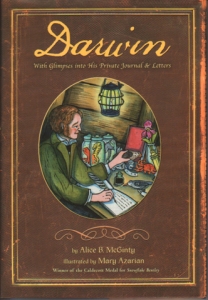
Find more great Horn Book content at these links:
Recommended books: reviews and themed booklists
App and e-book reviews
Movie reviews
Event news and recaps
Events calendar
Happy birthday, Charles Darwin!
Charles Robert Darwin was born on this day in 1809.
Primary
 In Charlie and Kiwi: An Evolutionary Adventure, Eileen Campbell's age-appropriate, scientifically on-target discussion of evolution, Charlie and his toy-kiwi-come-alive are whisked back in time. They pick up "Grandpa Charles" (a goofy cartoon Darwin) in 1860, then hop back 30 million and 150 million years. At each stop, Grandpa Charles explains individual variation within populations and natural selection. Peter H. Reynolds's cheery cartoons and the kid-level humor keep the pace and tone upbeat. (Atheneum, 2011)
In Charlie and Kiwi: An Evolutionary Adventure, Eileen Campbell's age-appropriate, scientifically on-target discussion of evolution, Charlie and his toy-kiwi-come-alive are whisked back in time. They pick up "Grandpa Charles" (a goofy cartoon Darwin) in 1860, then hop back 30 million and 150 million years. At each stop, Grandpa Charles explains individual variation within populations and natural selection. Peter H. Reynolds's cheery cartoons and the kid-level humor keep the pace and tone upbeat. (Atheneum, 2011) Readers witness the six-million-year development of classic biogeography example the Galápagos in Jason Chin's Island: A Story of the Galápagos. The organizational structure — five chronological chapters — echoes the story line and underscores the ecological message. Chin's gorgeous illustrations include sweeping double-page spreads and panels arranged to show dynamic changes (e.g., species adaptation). Back matter addresses natural selection, volcano formation/plate tectonics, and endemic species. An author's note discusses scientific facts versus speculation. (Roaring Brook/Porter, 2012)
Readers witness the six-million-year development of classic biogeography example the Galápagos in Jason Chin's Island: A Story of the Galápagos. The organizational structure — five chronological chapters — echoes the story line and underscores the ecological message. Chin's gorgeous illustrations include sweeping double-page spreads and panels arranged to show dynamic changes (e.g., species adaptation). Back matter addresses natural selection, volcano formation/plate tectonics, and endemic species. An author's note discusses scientific facts versus speculation. (Roaring Brook/Porter, 2012)Intermediate
 Author Kathleen Krull makes no bones about Darwin's influence in Charles Darwin [Giants of Science]: "Publication day [for On the Origin of Species]…is considered the birthday of modern biology." A useful introduction previews his life and accomplishments, acquainting readers with both the man and the scientist. Krull’s lively writing fleshes out these points, particularly emphasizing Darwin’s uncertainty about publication. Boris Kulikov's occasional art brings humor and drama to this brisk account. (Viking, 2010)
Author Kathleen Krull makes no bones about Darwin's influence in Charles Darwin [Giants of Science]: "Publication day [for On the Origin of Species]…is considered the birthday of modern biology." A useful introduction previews his life and accomplishments, acquainting readers with both the man and the scientist. Krull’s lively writing fleshes out these points, particularly emphasizing Darwin’s uncertainty about publication. Boris Kulikov's occasional art brings humor and drama to this brisk account. (Viking, 2010) In Alice B. McGinty's Darwin, readers can consider Darwin from two points of view: his own and his biographer's. The primary narrative follows the voyage of the Beagle, and nearly every spread contains a parchment-like "letter" including edited portions of Darwin's own diary and letters. Mary Azarian's watercolor-tinted woodcuts evoke naive art of the period. A brief author's note and source notes are appended to this revealing work. (Houghton, 2009)
In Alice B. McGinty's Darwin, readers can consider Darwin from two points of view: his own and his biographer's. The primary narrative follows the voyage of the Beagle, and nearly every spread contains a parchment-like "letter" including edited portions of Darwin's own diary and letters. Mary Azarian's watercolor-tinted woodcuts evoke naive art of the period. A brief author's note and source notes are appended to this revealing work. (Houghton, 2009) With Billions of Years, Amazing Changes: The Story of Evolution, Laurence Pringle traces scientific developments that led to Darwin's On the Origin of Species as well as subsequent discoveries that have contributed to understanding of species change. Straightforward explanations of such concepts as natural selection, genetic mutations, and speciation are woven through the historical timeline, making even the most complex ideas understandable. Copious illustrations include photographs, diagrams, and Steve Jenkins's wonderfully detailed cut-paper illustrations. (Boyds, 2011)
With Billions of Years, Amazing Changes: The Story of Evolution, Laurence Pringle traces scientific developments that led to Darwin's On the Origin of Species as well as subsequent discoveries that have contributed to understanding of species change. Straightforward explanations of such concepts as natural selection, genetic mutations, and speciation are woven through the historical timeline, making even the most complex ideas understandable. Copious illustrations include photographs, diagrams, and Steve Jenkins's wonderfully detailed cut-paper illustrations. (Boyds, 2011)
Author/illustrator Peter Sís translates Darwin's written legacy into visual narrative in The Tree of Life: A Book Depicting the Life of Charles Darwin, Naturalist, Geologist & Thinker, an extraordinary book that explores Darwin's life, work, and sources of inspiration. The climax of the book — and of Darwin's work, Sís implies — is On the Origin of Species, which Sís presents as an extravagant gatefold spread. The detailed illustrations and narrative complexities demand of readers the same process Darwin set for himself: observe carefully, make connections, and learn. (Farrar/Foster, 2003)
Older
 With empathy and humor, Deborah Heiligman's Charles and Emma: The Darwins' Leap of Faith examines Darwin's legacy through the unique lens of his domestic life. Charles's wife Emma, devoutly religious, supported him but feared for his eternal welfare. Charles, in turn, wanted to please Emma, but not at the expense of science. This relevant book works as a history of science, a biography, and a romance. (Holt, 2009)
With empathy and humor, Deborah Heiligman's Charles and Emma: The Darwins' Leap of Faith examines Darwin's legacy through the unique lens of his domestic life. Charles's wife Emma, devoutly religious, supported him but feared for his eternal welfare. Charles, in turn, wanted to please Emma, but not at the expense of science. This relevant book works as a history of science, a biography, and a romance. (Holt, 2009) In Charles Darwin: The Life of a Revolutionary Thinker, Dorothy Hinshaw Patent presents conflicting opinions from scholars and is clear when she draws her own conclusions. Photos of Darwin's notes and books allow readers to see his thinking process, from making lists to examining barnacles. Considerable attention is given to Darwin's scientific process of observing, questioning, collecting, hypothesizing, testing, concluding, and writing. (Holiday, 2001)
In Charles Darwin: The Life of a Revolutionary Thinker, Dorothy Hinshaw Patent presents conflicting opinions from scholars and is clear when she draws her own conclusions. Photos of Darwin's notes and books allow readers to see his thinking process, from making lists to examining barnacles. Considerable attention is given to Darwin's scientific process of observing, questioning, collecting, hypothesizing, testing, concluding, and writing. (Holiday, 2001) 
RECOMMENDED
ALREADY A SUBSCRIBER? LOG IN
We are currently offering this content for free. Sign up now to activate your personal profile, where you can save articles for future viewing.







Add Comment :-
Comment Policy:
Comment should not be empty !!!
Linda Baie
All terrific books. I would add Darwin: A Life In Poems by Ruth Padel. It is a treasure of a telling of his life, too! Thanks!Posted : Feb 13, 2014 12:22